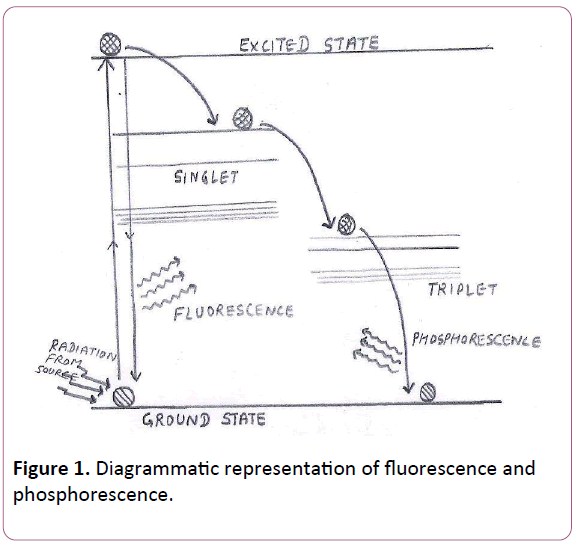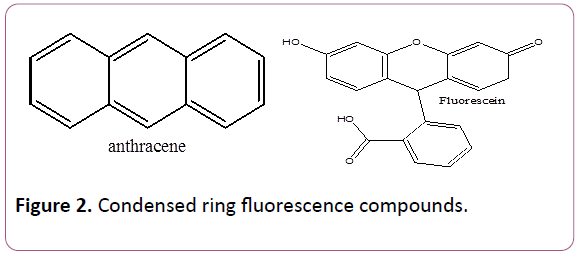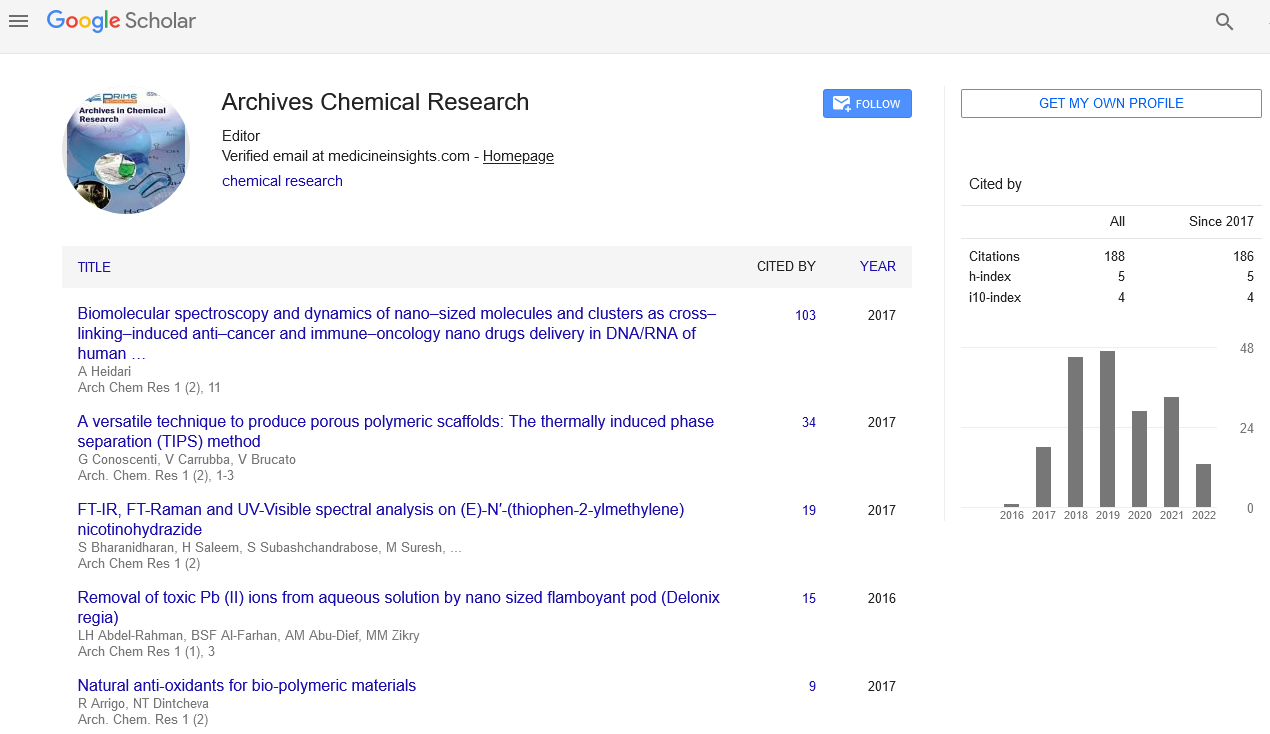Deepak Chowrasia* and Nisha Sharma
University Institute of Pharmacy, CSJM University, Kanpur-208024, India
*Corresponding Author:
Deepak Chowrasia
University Institute of Pharmacy, CSJM University, Kanpur-208024, India
Tel: +91-9451-019049
E-mail: chowrasia.deepak@gmail.com
Received date: 17 October, 2017; Accepted date: 30 October, 2017; Published date: 06 November, 2017
Citation: Deepak C, Sharma N (2017). Chemistry of Fluorimetric Analysis and their Gradient in Validation of Therapeutic Molecules. Arch Chem Res. Vol.2 No.1: 3. doi: 10.21767/2572-4657.100016
Copyright: © 2017 Deepak C, et al. This is an open-access article distributed under the terms of the Creative Commons Attribution License, which permits unrestricted use, distribution, and reproduction in any medium, provided the original author and source are credited.
Keywords
Fluorescence; Fluorimetry; Therapeutic molecules
Introduction
Florescence and phosphorescence are two key manifestations of photoluminescence providing mechanistic pathway for movement of electrons from higher to lower energy state, emitting excess energy in form of radiation in electromagnetic spectrum, constituting a newer type of emission spectroscopy known as fluorescence spectroscopy or more conveniently fluorimetry. Fluorimetry principally measures the fluorescence and/or phosphorescence property of a chemical entity and correlate it with concentration via flourimeter (a device use to measure fluorescence intensity). The brighter side of fluorimetry lies in its sensitivity, selectivity, and accuracy making it a highly efficient instrumental technique comparatively for both qualitative and quantitative analysis of therapeutic molecules.
Principle
Since photoluminescence is a phenomenon of irradiation followed by absorption, the same sequel consequences platforms the backbone of fluorimetry which aid-up in quantitative analysis by recording the induce fluorescence intensity of a chemical entity, which is also one of its main analytical limitation. As per the theory dealing with molecular orbital, energy state or levels of a molecule can subsequently be divided into ground as well as excited state. Normally, molecules are tends to be acquire most stable energy state which is also be known as the ground state. However when exposed to certain energy resource (electromagnetic radiation-as here in case of fluorimetry), absorb the same and excited hence transit from ground to higher energy state. On the basis of extent of energy soak by the molecule its transition level/s varies from first, second, third and so on. As the excited state whatsoever it may be, is relatively unstable thus to achieve the universal state of stability, the excited molecules transit back to their minimum energy level i.e. the ground state. During this jump-back phenomenon the excess energy is irradiated back (no to the source), but to the external environment subsequently thus making the system in a state of perfect energy balance. The jump back phenomenon (Figure 1) of excited electron may be direct within a level as in case of fluorescence or may be indirect (via intersystem crossing) for phosphorescence or stepwise fluorescence manifesting the principle of fluorimetry.

Figure 1: Diagrammatic representation of fluorescence and phosphorescence.
For analytical point of view, the jump-back phenomenon induce fluorescence intensity is correlated which mathematically is directly proportional to the concentration of test substance/ therapeutic entity permitting its quantification practically.
Fluorescence Efficiency of a Therapeutic Molecules
Therapeutic molecules since differ among substantially in their physiochemical property thus it is a difficult task to determine or calculate their fluorescence efficacy thou universally the same can be calculated depending on their chemical structure and correlating them with universal terms known as Quantum Yield. Quantum yield depicts the fluorescence power of a fluorophore-chemical system having efficiency for fluorescence. Alternatively, Quantum yield can be defined as a ratio of quantity of light emitted to the ratio of quantity of light absorbed by a chemical system. Symbolically quantum yield can be denoted as Φ and mathematically expressed as

Ideally, quantum yield of a chemical system or therapeutic molecule is always less than one due to difference in emitted & absorbed radiation as per universal rule, more rigid structure of a therapeutic entity greater value of quantum yield, thus better the fluorescence. For example condensed ring organic compounds like anthracene and fluorescein exhibits good flourescence compare to mono and bicyclic condensed aromatic ring system (Figure 2).

Figure 2: Condensed ring fluorescence compounds.
Ideally, quantum yield of a chemical system or therapeutic molecule is always less than one due to difference in emitted & absorbed radiation as per universal rule, more rigid structure of a therapeutic entity greater value of quantum yield, thus better the fluorescence. For example condensed ring organic compounds like anthracene and fluorescein exhibits good flourescence compare to mono and bicyclic condensed aromatic ring system (Figure 2) [1-3].
Quenching and Fluorescence Intensity
Quenching may be defined as any process irrespective to its origin responsible for interfering (especially reducing) the fluorescence intensity exhibited by a chemical system. The substance/phenomenon so as involved in quenching is termed as quencher. Numerous reported processes such as radiationless energy transfer, collision deactivation, breakage of chemical bonds, chemical complexation phenomenon, high concentration, adsorption, and absorption of flourescence radiation by another substance present in same solution ultimately results in reducing flourescence intensity thus can be alternatively be termed as quencher. Rather than the aforesaid physiochemical phenomenon other well documented quencher includes temperature, viscosity of dispense system/solvent, nature of solvent used to prepare test substance, wavelength of light absorbed by the chemical entity, adsorption, scattering of light within the system by dispersed molecule, number of bonds and their strength, functional groups (Table 1), type of ring system, ring substituent (Table 2), structure rigidity, oxygen atom, pH of system etc.
| Functional groups |
Intensity effect |
Wavelength effect |
Alkyl
Cyno
Hydroxyl,methoxy,ethoxy
COOH,CHO,COOR,COR
-SH
-SO3H
Halogens
NO, NO2
NH2, NHR,NR2 |
-
*
+
+
+
*
+
+
+ |
-/+
+
+
-
-
*
-
+
+ |
Table 1: Some functional groups & their effect on flourescence intensity; *=No effect; __ Reduction; + Enhancement .
| Chemical compound |
Flourescence wavelength (nm) |
Flourescence relative intensity |
Benzene
Propyl benzene
Fluoro benzene
Chloro benzene
Bromo benzene
Iodo benzene
Phenol
Aniline
Benzoic acid
Nitrobenzene |
270-310
270-320
270-320
275-345
290-380
Nil
285-365
310-405
310-390
Nil |
10
17
10
7
5
0
18
20
3
0 |
Table 2: Effect on flourescence intensity on ring substitution.
Instrumental Prospective of Fluorimetry
On the basis of path followed by the beam of light from source to detector and nature of components employed in manufacturing, a fluorimeter can be a single beam filter fluorimeter, double beam filter fluorimeter, and spectrofluorimeter. The single beam filter fluorimeters are inexpensive utilizes tungsten lamp as source of illumination, consisting optical system (primary & secondary filter) allowing only mono-directional passage of light beam from source to sample cell and finally to detector. These instruments are usually simple in construction, cost effective, easy to handle, and are handy to maintain. On other hand a double beam filter fluorimeter thou analogues in design with that of single beam however exceptionally inbuilt with two pairs of optical system each handle beam independently. In this type of instrument, incidence beam of light from source passes separately & simultaneously to sample as well as reference cell via different primary filters. Finally, the emitted radiation from sample and reference cell is transmitted towards detector with the help of secondary filters laying apart each other thus enhancing its applicability for simultaneous determination of sample & reference without compromise of time. The spectrofluorimeter is the next highly efficient and technically modified version of fluorimeter which rather makes use of monochromator rather than conventional filter assembly which ultimately enhance the sensitivity of analytical process-a prime criteria for quantification of therapeutic molecules. These instruments are thus highly sensitive, accurate comparatively and can conveniently be used for rapid scanning of emission and excitation spectrum [4-6].
Conclusion
Indubitably, the technique of fluorimetry is an officially validated tool for both qualitative and quantitative determination of therapeutic molecules. However its limitations much be well manageable and identified analytically.
References
- Christian GD (2004) Analytical Chemistry, (6th edn), John Wiley & Sons, Hoboken, New Jersey: USA.
- Sigga S (1968) Survey of Analytical Chemistry, McGraw-Hill, New York.
- West W (1968) Technique of Organic chemistry. Chemical application of spectroscopy, (2nd edn), Interscience, New York.
- Silverstein RM (1980) Spectroscopic identification of organic compounds, (5th edn), Wiley Interscience, New York.
- Taylor JA (1987) Quality Assurance of Chemical Measurement, Lewis publisher incl. Chelsea, MI, USA.




